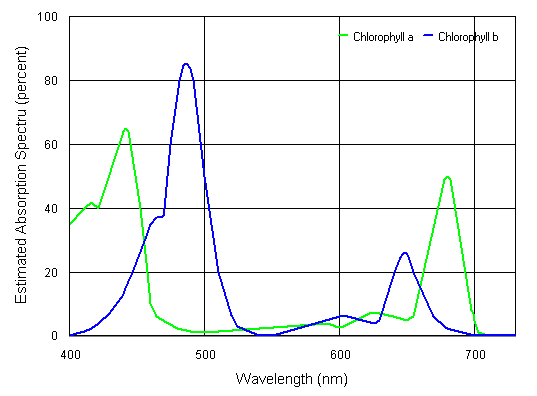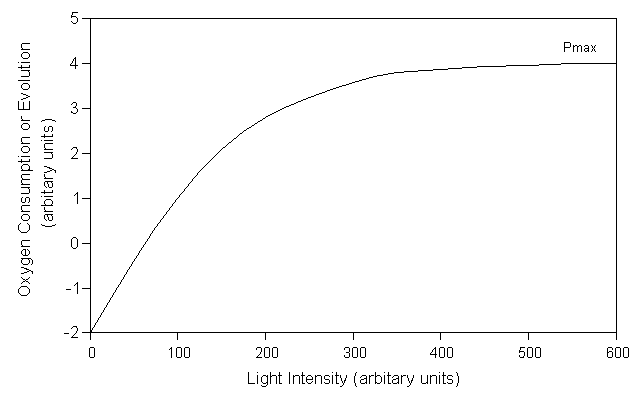
Figure 1: Estimated absorption spectra of chlorophylls a and b (After Raven et al. 1976).
Photosynthesis is an extremely significant biological process and is largely responsible for life on earth as we know it. I will give a brief explanation of the process of photosynthesis and discuss aspects relating to photosynthesis and the organisms that use and are affected by the process.
In simple terms, photosynthesis is the process where energy from light is used to convert carbon dioxide and water into carbohydrates. The ability of photosynthesis is limited to true plants, most algae (including cyanobacteria) and some bacteria. The process in bacteria (other than cyanobacteria) is usually different from plants and algae in that substances other than water are utilised.
The process of photosynthesis can be summarised in the following formula:
A pigment is any substance that absorbs light. The colour of a pigment indicates the wavelengths of light they absorb, or more accurately the wavelengths of light they don't absorb. A black pigment absorbs all light. A green pigment absorbs all but green light.
Pigments play an important role in photosynthesis as they capture the energy from the light. The photosynthetic pigments used by plants and eukaryotic algae are held inside organelles called chloroplasts.
The chlorophylls are the most important pigments in photosynthesis, but the carotenoids and the phycobilins also play a part. There are a few different kinds of chlorophyll, but chlorophyll a is the most widespread, being found in all photosynthetic eukaryotes and cyanobacteria (Raven et al.1976). Chlorophyll a absorbs mostly violet, blue and red light. The pattern of wavelengths absorbed by a pigment is known its absorption spectrum. The absorption spectrum of chlorophylls a and b is shown in Figure 1. The spectrum for a pigment (or mix of pigments) that shows the relative effectiveness of wavelengths is known as its action spectrum.

Figure 1: Estimated absorption spectra of chlorophylls a and b (After Raven et al. 1976).
Chlorophyll a directly absorbs light energy for use in photosynthesis. Other pigments, known as accessory pigments, absorb light energy and transfer it to chlorophyll a. These pigments supplement the wavelengths of light absorbed by chlorophyll a and so increase the wavelengths available for photosynthesis. Accessory pigments include chlorophylls b, c and d, carotenoids (carotenes, carotenols, xanthophylls), phycobilins (phycocyanin (blue) and phycoerythrin (red)).
While true plants, eukaryotic algae and cyanobacteria all utilise chlorophyll a, different classes of plants and algae use different accessory pigments as shown in Table 1. The pigments utilised by a plant or alga will largely determine what wavelengths of light that the plant or alga can use for photosynthesis as shown in Figure 2.
| Group | Pigments |
| Green algae | Chlorophyll a and b α-, β-,γ-carotenes, several xanthophylls |
| Brown algae | Chlorophyll a and c β-carotene, fucoxanthin and several other xanthophylls |
| Diatoms | Chlorophyll a and c α-, β-,ε-carotenes, fucoxanthin and several other xanthophylls |
| Dinoflagellates | Chlorophyll a and c β-carotene, several xanthophylls |
| Red algae | Chlorophyll a and d α-, β-carotenes, several xanthophylls R- and C-phycocyanin, R- and B-phycoerythrin |
| Cyanobacteria | Chlorophyll a β-carotene, several xanthophylls C-phycocyanin, allophycocyanin, C-phycoerythrin |
 Figure 2: The absorption and action spectra of a green alga (Ulva taeniata), a brown alga (Coilodesme californica) and a red alga (Porphyra naiadum) with the absorption spectra of some of the major photosynthetic pigments found in these algae (Raven et al. 1976).
Figure 2: The absorption and action spectra of a green alga (Ulva taeniata), a brown alga (Coilodesme californica) and a red alga (Porphyra naiadum) with the absorption spectra of some of the major photosynthetic pigments found in these algae (Raven et al. 1976).
The term respiration can be used to refer to activities at the organism level or at the cellular level. The former is analogous to "breathing" where the organisms exchanges oxygen for carbon dioxide with the environment. Cellular respiration is the process where energy from carbohydrates is made available to the cell. In aerobic cellular respiration glucose (or other carbohydrate) is oxidized to release energy and produces carbon dioxide and water. This is very much the reverse of photosynthesis as can be seen from the following formula:
As photosynthesis liberates oxygen and consumes carbon dioxide in proportion to the rate of photosynthesis, measuring the rate of oxygen production or carbon dioxide consumption are ways to measure the photosynthetic rate. However, as the organism is also respiring, it is only possible to measure the net production of oxygen or net consumption of carbon dioxide. The rate of oxygen consumption or carbon dioxide production of a photosynthetic organism can be measured in the dark and used as a base, although this assumes the respiration rate is constant and this may not be true. In most cases, the net effects of photosynthesis are measured in order to determine the rate of photosynthesis.
There is a direct relationship between light intensity and photosynthesis. With very low light intensity, the rate of photosynthesis may be less than that of respiration. As the intensity increases, the photosynthetic rate reaches the respiration rate and then exceeds it. The initial correlation is linear with the rate of photosynthesis increasing in direct proportion to the increase in light intensity. Photosynthesis can become saturated by light and the rate reaches a plateau which is the maximum photosynthetic rate (Pmax). The relationship between light intensity and photosynthesis is shown in an idealised photosynthesis-irradiance (P-I) curve in Figure 3 where oxygen consumption/production is used to measure the rate of photosynthesis.

Figure 3: Idealised photosynthesis-irradiance (P-I) curve (After Falkowski et al, 1990).
Photosynthetic organisms rely on light to supply them with the energy to survive. Most are able to store the energy they capture from light as carbohydrates, such as starch, or polysaccharides such as paramylon. Being able to store energy enables them to survive under conditions of low light intensity when photosynthesis exceeds respiration, such as night or overcast days. In the long term, however, photosynthesis must exceed respiration or they will exhaust their stores and die.
As the rate of photosynthesis is dependent on the amount of irradiation the organisms receives and the amount of darkness they endure determines how much of their reserves they will use, the combination of intensity and photoperiod determines how much light is "enough". More light means a greater rate of photosynthesis
References
Bold H.C. and Wynne M.J. 1978. Introduction to the Algae: Structure and Reproduction. Pentice-Hall, Englewood Cliffs, NJ. 706pp.
Falkowski P.G., Jokiel P.L. and III R.A.K. 1990. Irradiance and Corals.. In: Coral Reefs: Ecosystems of the World, Vol 25 (Z.Dubinsky, ed) :89-108.
Raven P.H., Evert R.F. and Curtis H. 1976. Biology of Plants. Worth Publishers, New York, NY. 685pp.
Last updated: September 22, 2004